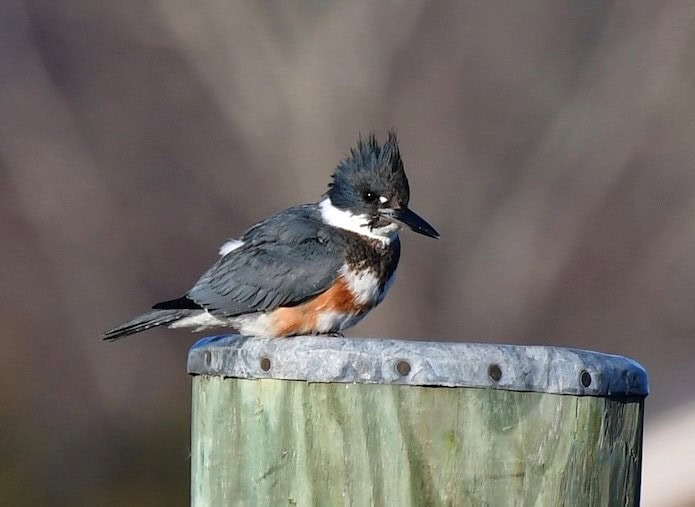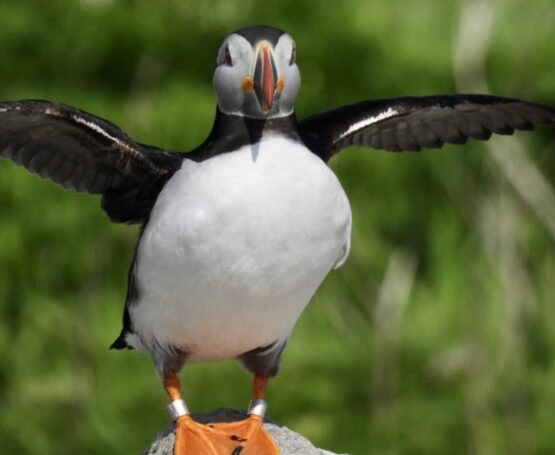
INTRODUCTION
Cruisers in the waters of Maine have a unique opportunity to observe birds and animals in their natural environments. Here are a few suggestions to make your onboard birdwatching more rewarding and enjoyable.
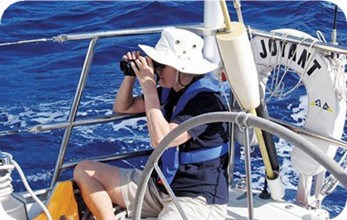
The tools for watching birds are probably already aboard your boat. The same binoculars you use to spot the running lights on ships at night work well for watching seabirds while underway. Stabilized binoculars can help, but when the waves increase, the point arrives when the naked eye works just as well.
A camera, stand-alone or as part of a phone or tablet, is usually part of every boat’s gear. A picture not only preserves the memory but helps identify what you see. Even a poor picture can be a great help when you consult an identification source.
Many excellent wildlife identification guides are available. Here are a few books we recommend:
- Sibley, David: Birds of Eastern North America – beautiful and accurate drawings
- Howell, Steve N. G, and Kirk Zufelt: Oceanic Birds of the World – for pelagic birds
- Tove, Michael: Guide to the Offshore Wildlife of the Northern Atlantic – older but still available, includes birds and other ocean animals in one volume.
- Nick Lund, American Birding Association Field Guide to Birds of Maine – photos of all birds found in Maine, a good companion to Sibley’s drawings.
- Derek J. Lovich, Birdwatching in Maine, the Complete Site Guide – Also includes Bar Charts showing abundance for each month of the year and which sites are best for the most sought-after species.
Many birders are moving to phone apps for bird and wildlife identification. The Sibley app, Sibley Birds (2nd Edition), costs about $20 (for Android or iOS). It takes up memory space because it downloads the contents of the paper guide onto your phone or iPad. In addition to pictures, maps, and texts, the app can play bird sounds. All of its features are usable when you are offline. You can limit the birds shown to only birds occurring in your current state or province. The newest frontier in bird identification is the app that identifies the bird for you. The champion in this field is the free Merlin Bird ID (Android or iOS) by Cornell Laboratory of Ornithology. After you answer several questions about the mystery bird, Merlin gives you suggestions, starting with the most probable candidates. It can now also identify birds by sound. Although not infallible, it is remarkably accurate but requires an internet connection.
The eBird website ebird.org is another invaluable source for birding help. Its database has more than 1 billion bird sightings from all over the world. It is free, but you need to set up an account, and some of its features are not available offline. You can use eBird for ID tips, photos and information about individual species and locations where they have been seen recently. You can search for nearby “hotspots,” an eBird term for places known to be interesting for birding which are often also good for hiking. Local hotspots and data entry are also available on the free eBird Mobile App (Android or iOS).
Submitting your sightings and photos to eBird at Cornell Laboratory of Ornithology is a fun and interesting way to record what you see and contribute to the database. It is particularly valuable when birding in remote locations where fewer people visit. To make the contributions usable by scientists eBird asks you to record the number of birds you see, or at least a reasonable guess. They also request the time of day, number of minutes you spent birding, and distance traveled. If you are offshore, you can input using latitude and longitude. An easy way to quickly record where you saw a bird at sea is to create a waypoint on your GPS. The best way to introduce yourself to eBird is to complete the free self-paced course Ebird Essentials. On the eBird homepage, choose EXPLORE and scroll down to eBird Essentials, which puts you into the catalog of courses you can download.
Birds to Look For
The birds featured below are limited to those which cruisers would be likely to see offshore, nearshore and in harbors during the months of June through August.
Ducks
- Common Eider
Common eiders breed in northern latitudes as far south as Massachusetts and can be found in Maine year-round. They congregate near rocky shores and islands, often in flocks. The adult male is dramatic in spring and early summer breeding plumage of white with a black cap, sides and tail. By mid-July they are molting into duller eclipse plumage of dark brown with some white showing on the back. Males take 3 years in variable patterns of brown and white before attaining breeding plumage. Females are brown at all ages year-round. The head profile of all sexes and ages from the crown to the tip of the bill is nearly straight.
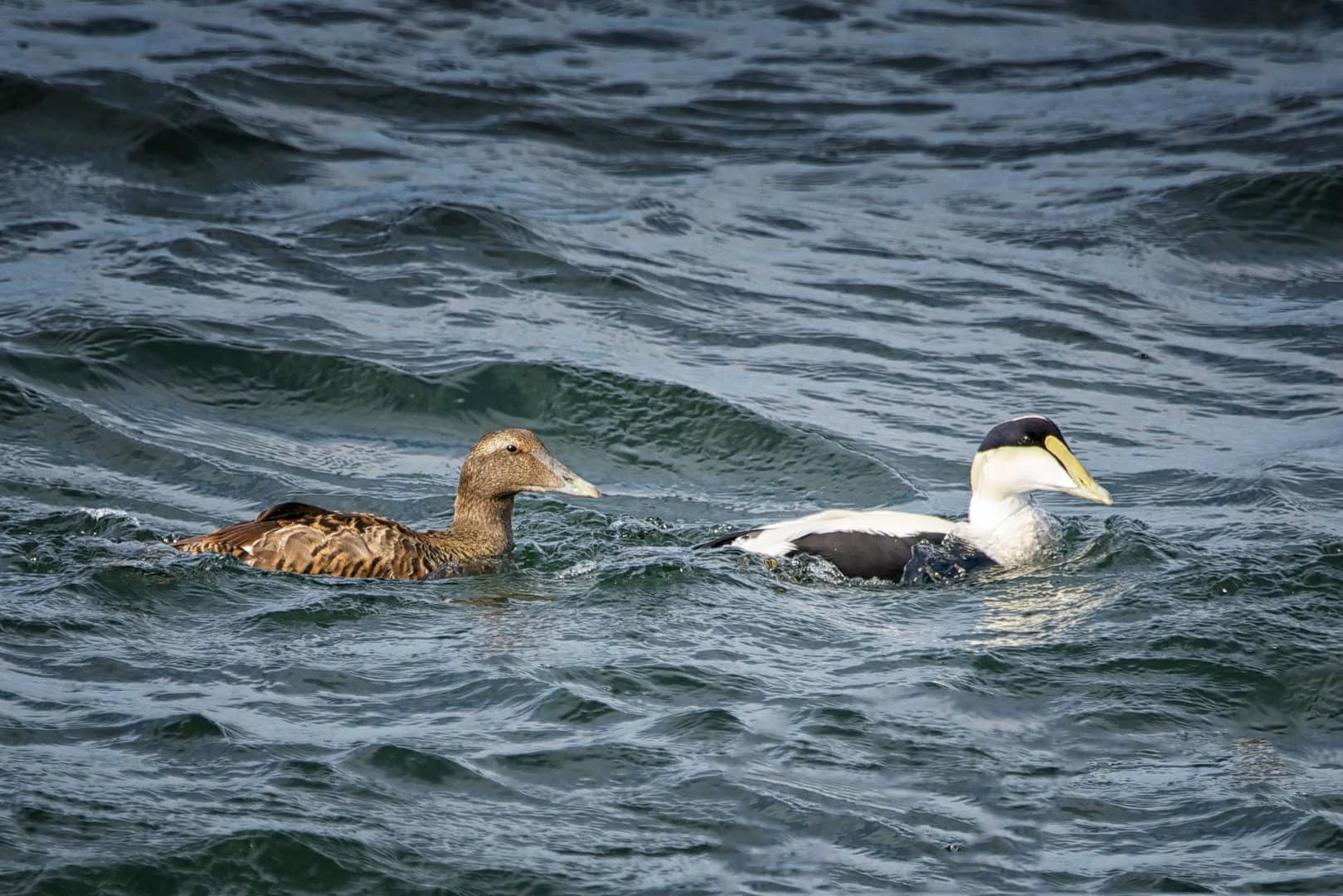
- Red-breasted Merganser
Maine is on the southern edge of the red-breasted merganser’s breeding range. They prefer nesting near salt or brackish water. They can be seen near isolated harbors and islands, joined by migrants from the north in late summer. The beautifully plumaged breeding males have green heads, red bills and eyes, a white neck collar and brownish-red breasts. Females have gray bodies and rust-colored heads. Both sexes have “punk hair-dos” of wispy feathers on the back of the head.

- Scoters
The three scoter species of sea ducks breed in the high Arctic and congregate in mixed species flocks offshore in Maine beginning in July. Males of all three species are primarily black and can be distinguished at a distance by body and bill patterns of contrasting white, yellow and orange. Females of all species are dark brown with subtle head pattern differences.
- Male surf scoters, the most common of the three in Maine, have white spots on the forehead and back of the neck. The bills are white, yellow and orange with a black spot near the base. Females have two diffuse white spots on the side of the head.
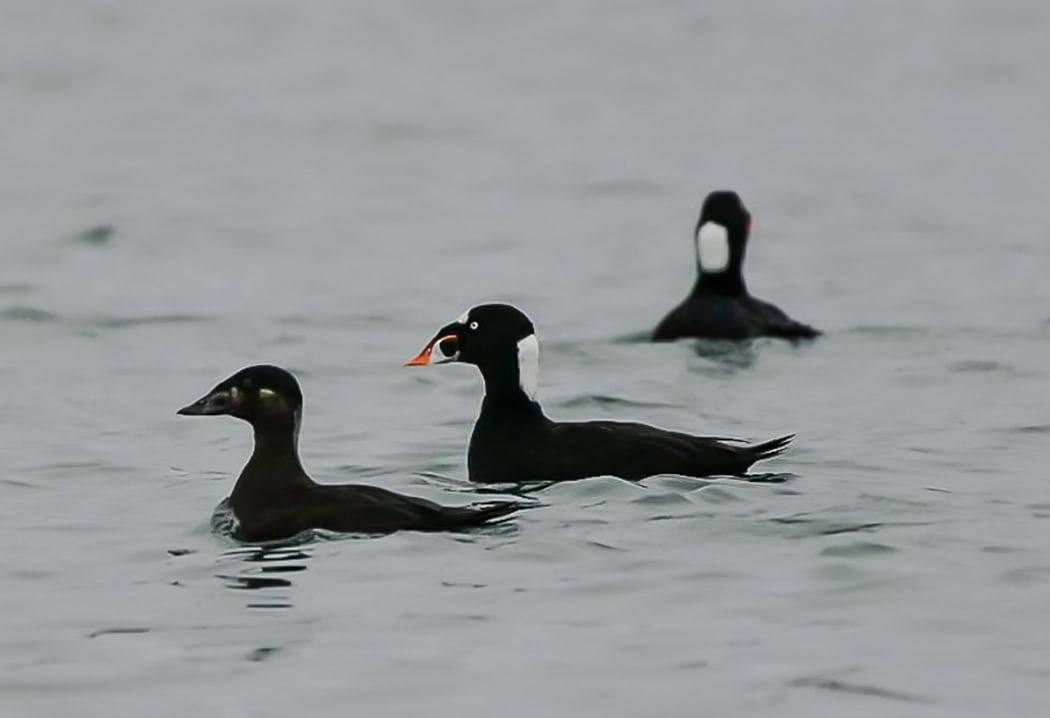
- White-winged scoters of both sexes can be separated from the other two species in flight by large white wing patches. Some of the white from the wings is usually visible on both sexes when they are swimming. The males also have a white spot below and behind each eye. Females show the same two defuse white face spots as the female surf scoters. Both sexes have a straighter head profile from crown to bill tip than the other scoter species.
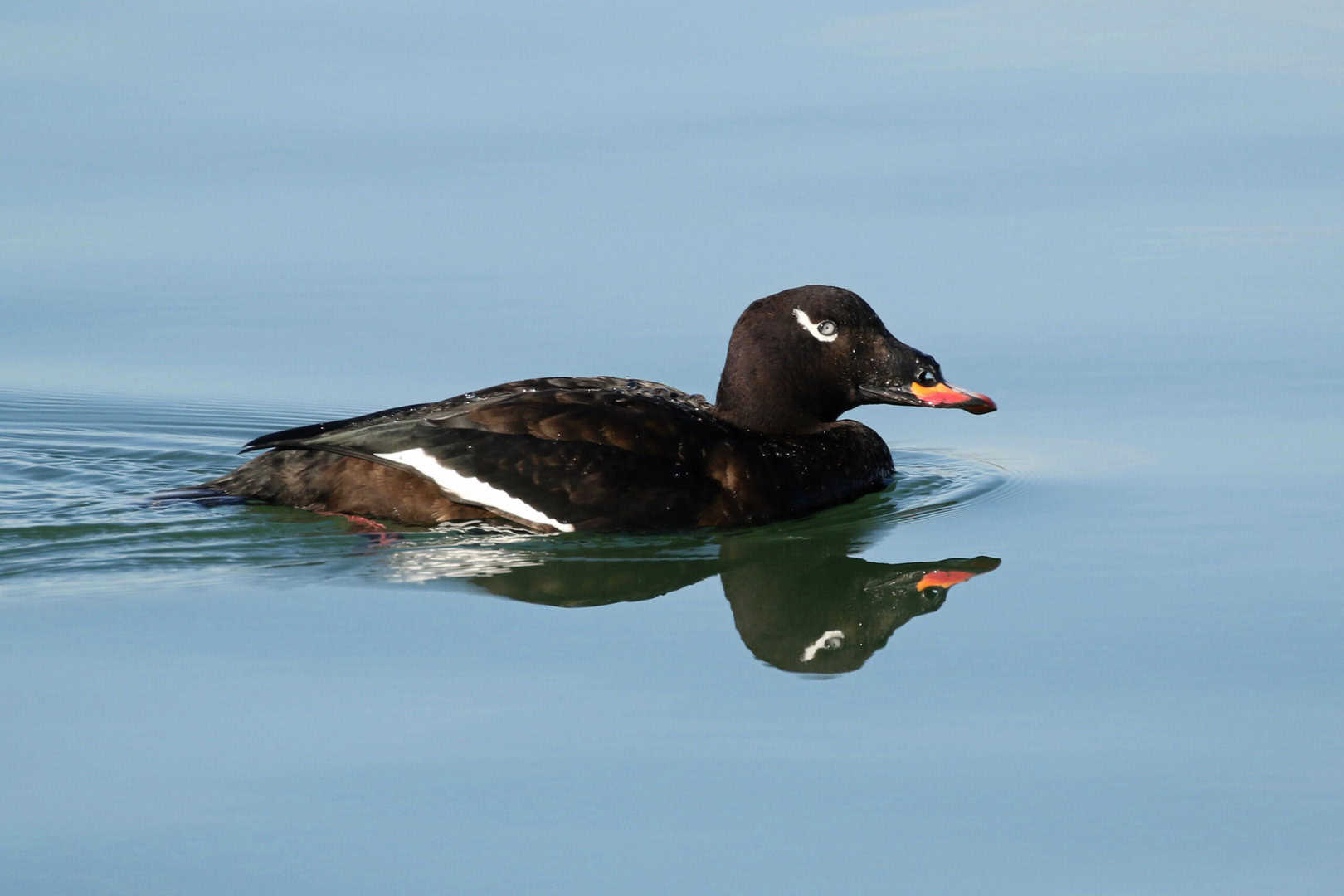
- Black scoters are smaller than the other two species. The males are entirely black except for a large yellow-orange knob above the bill. The faces on the brown females have a darker cap and lighter cheek.
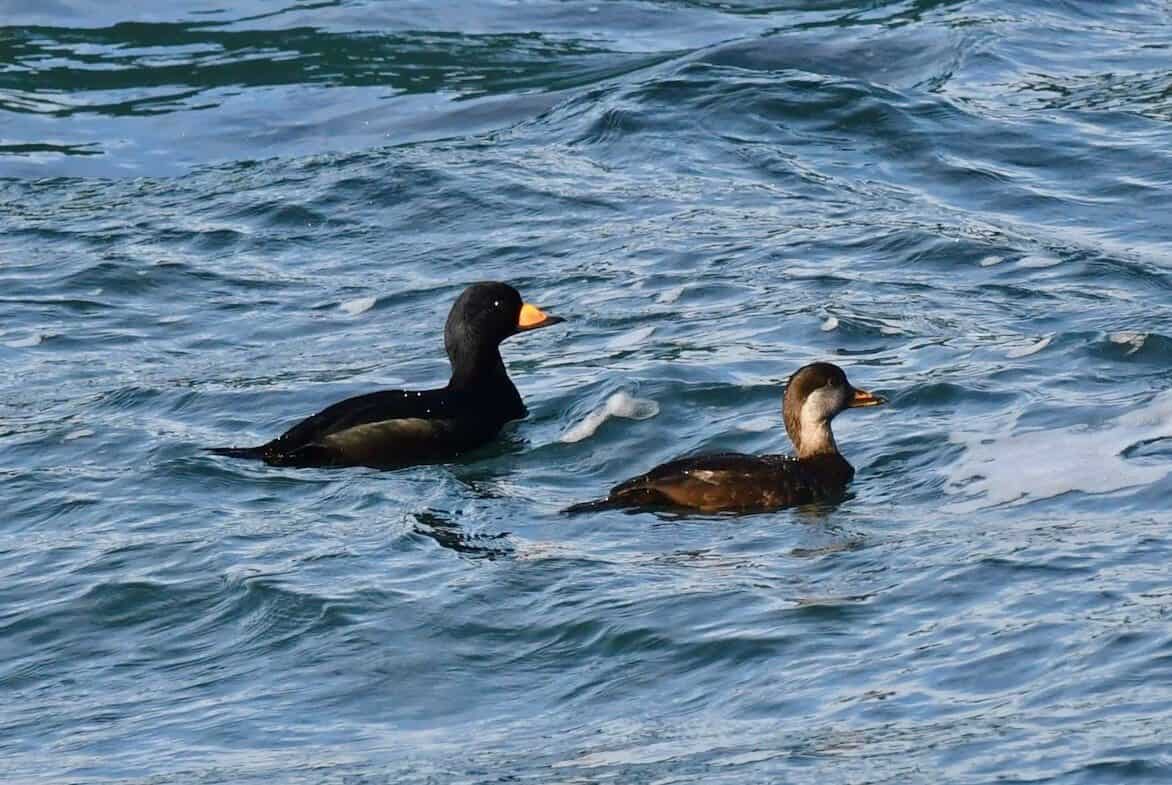
Auks
These members of the alcid family nest on rocky, predator free islands from March until mid-August, then disperse widely on the ocean to fish. They are primarily black and white. Due to their body shapes, they are jokingly referred to as “flying footballs.” The easiest places to view them are Eastern Egg Rock, Matinicus Rock, and Machias Seal Island. Landing on these islands is prohibited without a permit, but you can view them from your boat or find a tour operator in nearby shoreline towns.
- Atlantic Puffin
Puffins nest in burrows at the top of the rocks. They are easily distinguished from the other three species by their white faces and big yellow, orange and black bills.
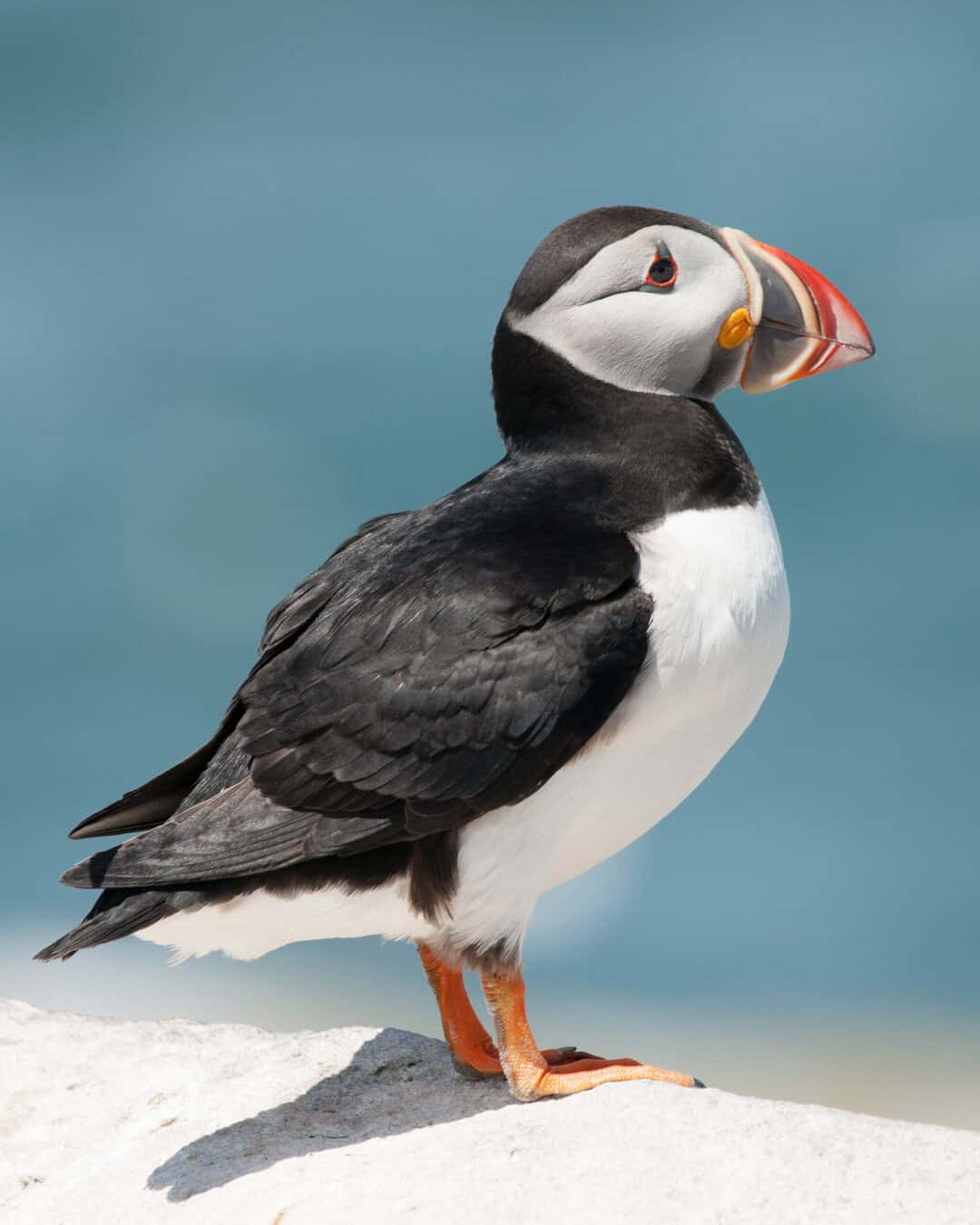
- Common Murre
Black on top and white below with pointed black bills, murres lay their eggs on rocky ledges with little or no nesting material. Be sure not to frighten them by coming too close because flushed adult may knock the eggs off of the nesting ledges.
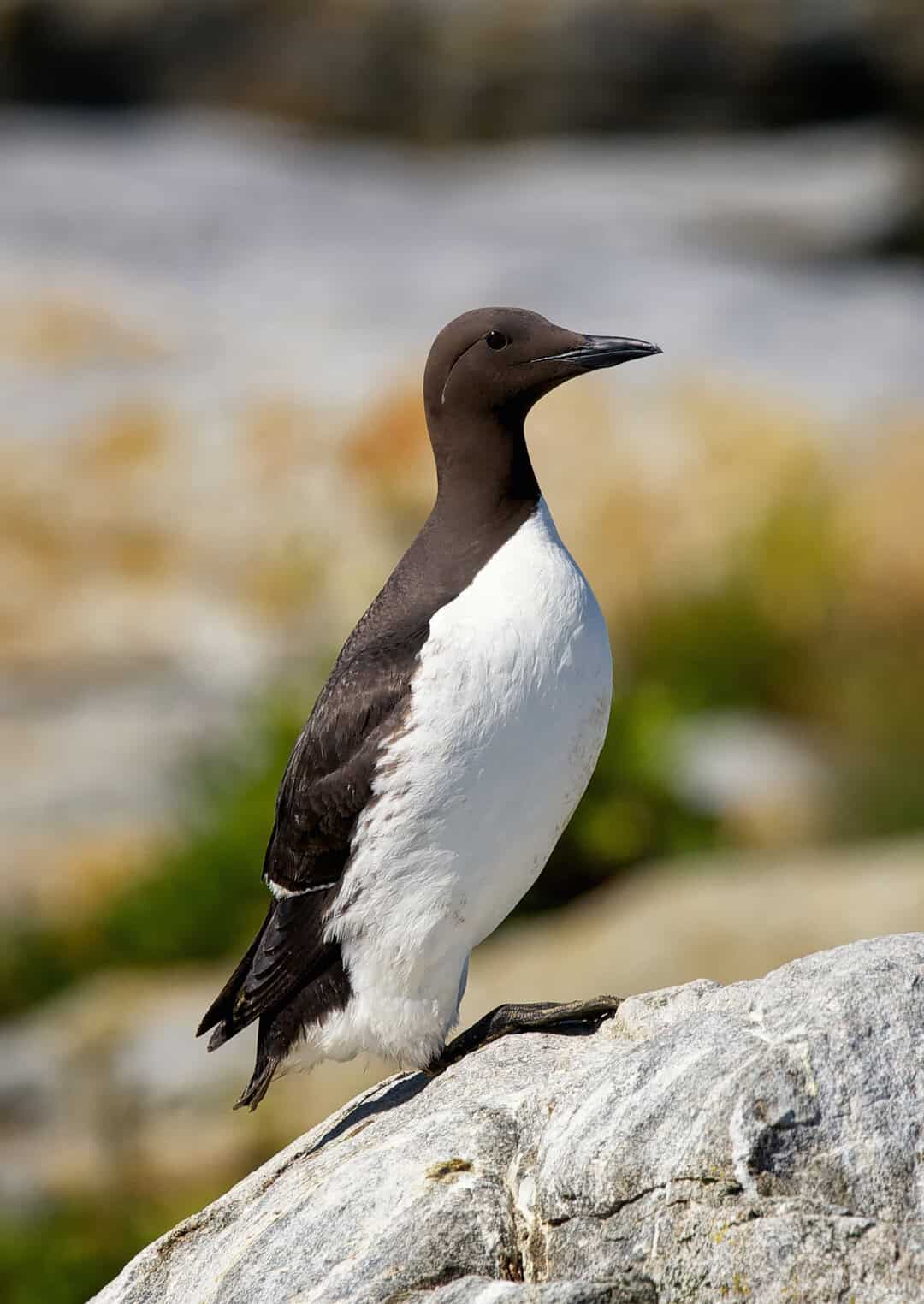
- Razorbill
Razorbills have the same black and white body pattern as common murres plus the same size and similar nesting habits. They can be distinguished by the blocky black bills which are thicker than on murres and have a horizontal white line from the bill base to below the eye and a vertical white stripe on the bill.
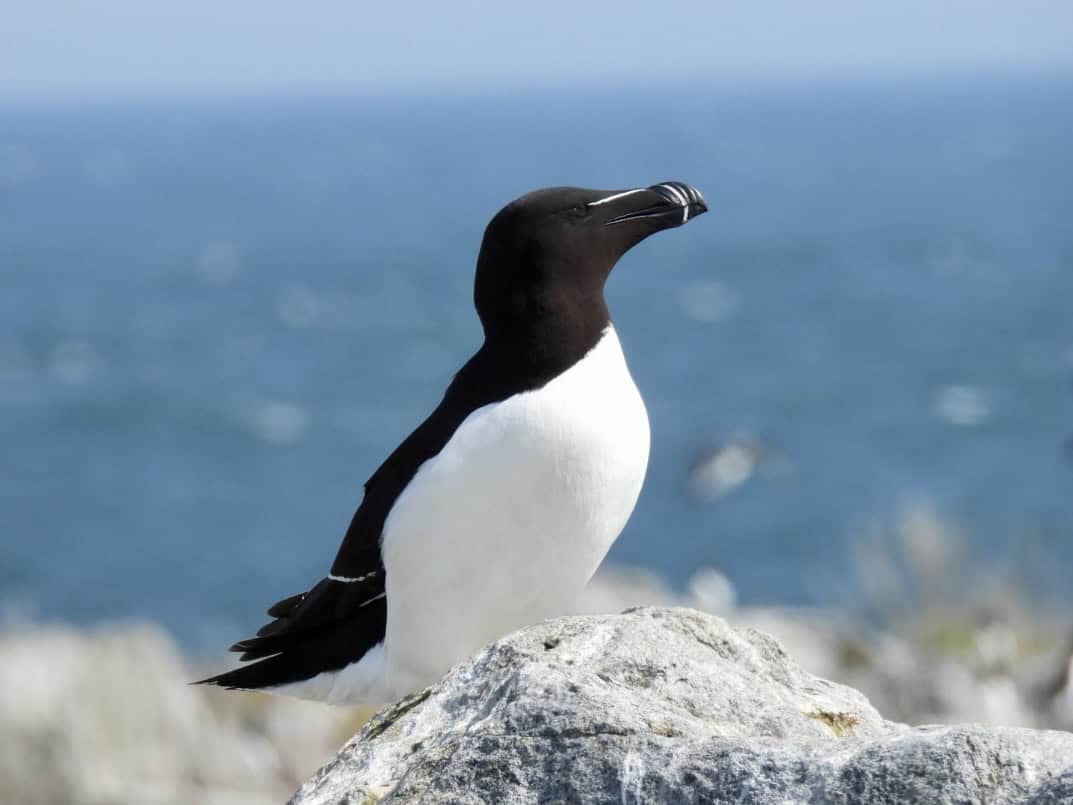
- Black Guillemots
Smaller than the other auks in Maine, the guillemots nest into the fall in cavities lower down on the rocks and are sometimes found closer to the mainland, even in harbors. They are entirely feathered in black except for large white wing patches. If you get a close view you will see that they have bright red legs and matching mouth linings.
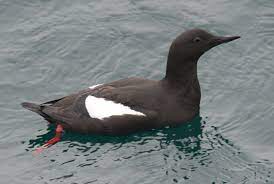
Gulls
Gulls breed everywhere along the coast of Maine, nesting in flocks on nearshore islands. Most people dismiss them all as just “seagulls.” In fact, there are four abundant species found in Maine—herring gull, great black-backed gull, ring-billed gull and laughing gull, plus three more less common species--lesser black-backed gull, Bonaparte’s gull and black-legged kittiwakes. Adult breeding gulls of both sexes are the same and are reasonably easy to sort out by the size of the bird and the color of the back, wing, bill and legs. Gulls take two or three years to attain adult plumage and during immature ages are more challenging to identify. The chart below shows the characteristics of Maine’s adult gulls.
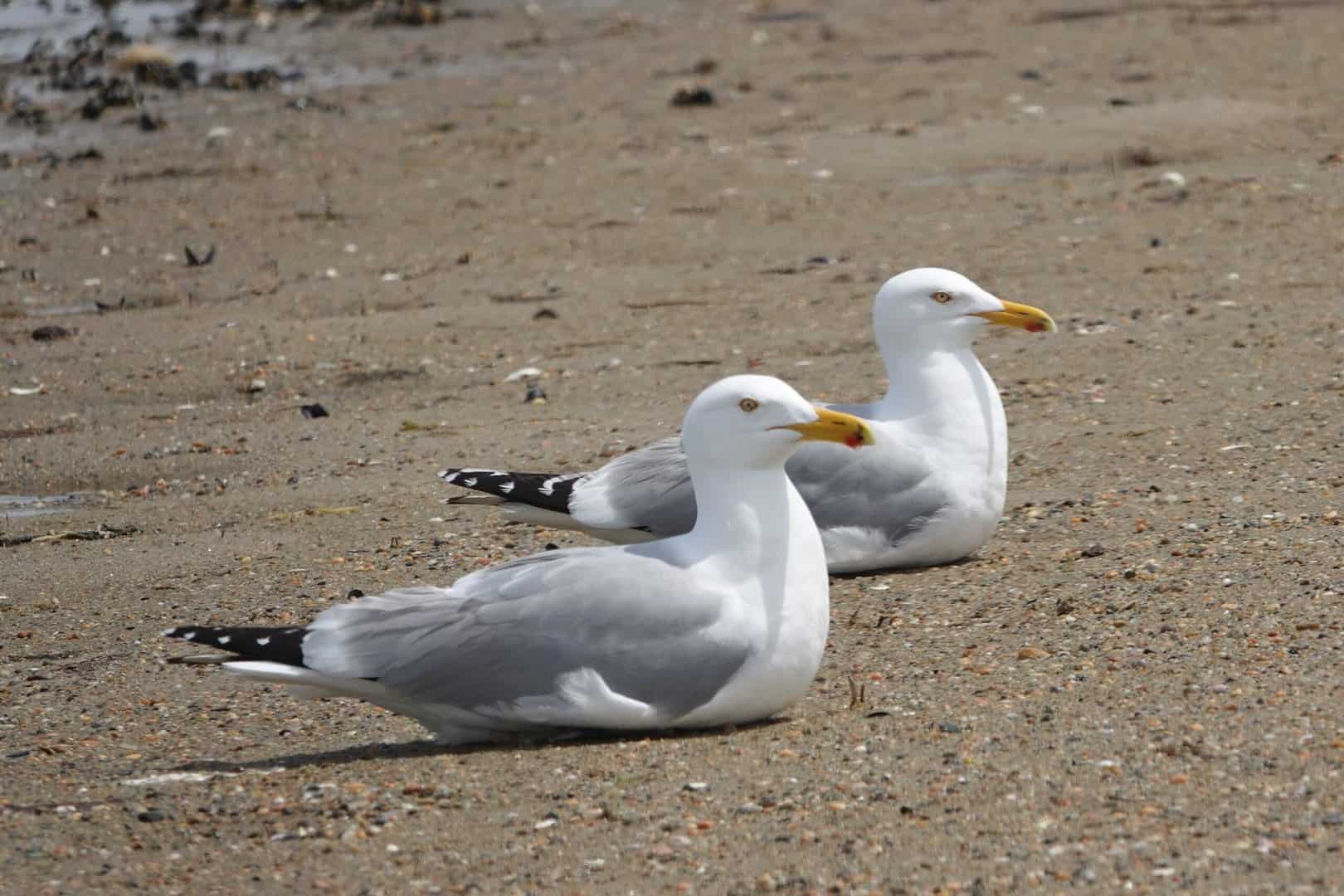
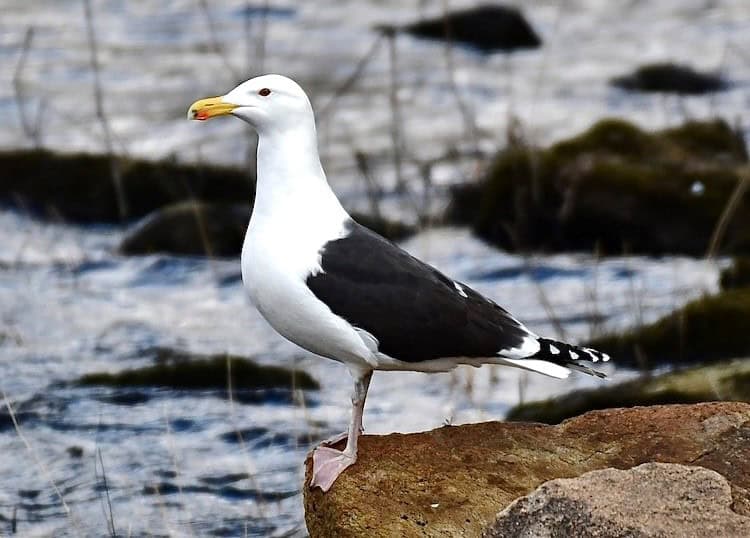
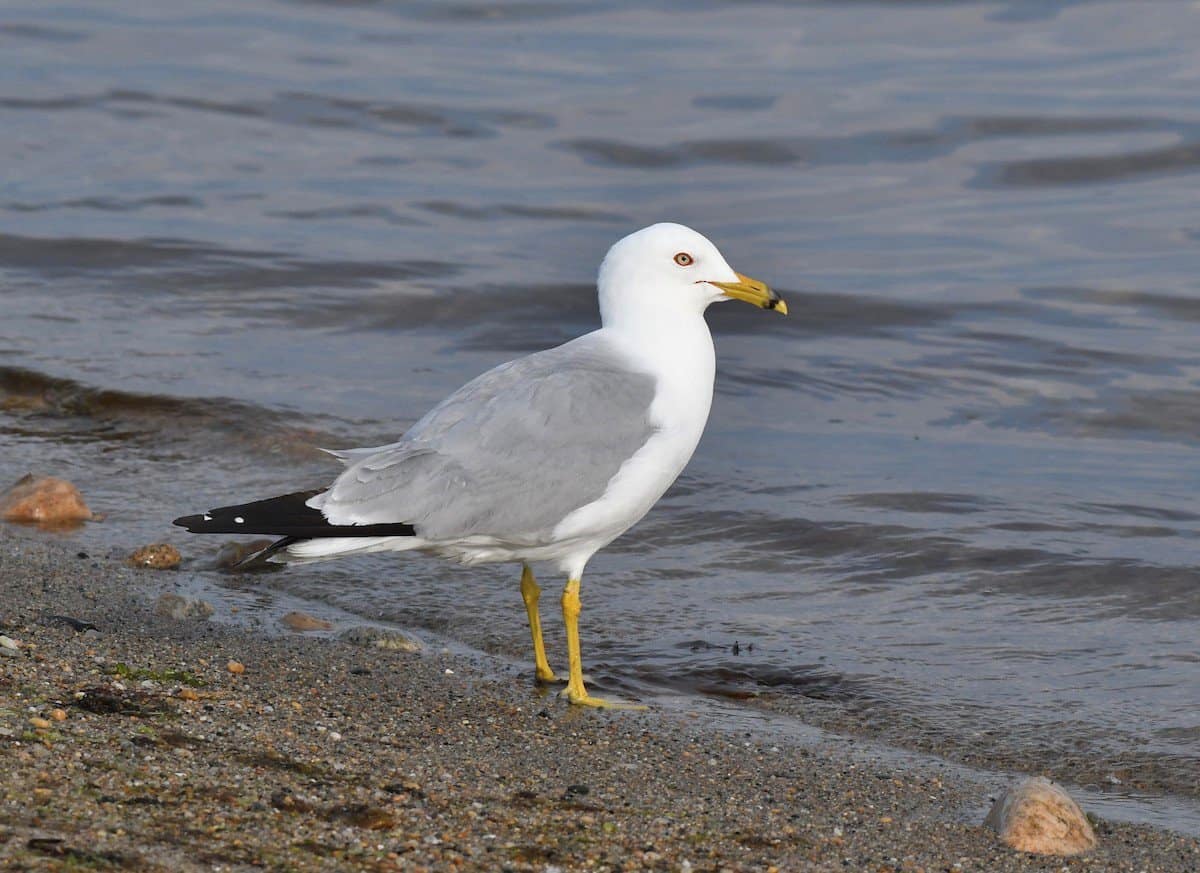

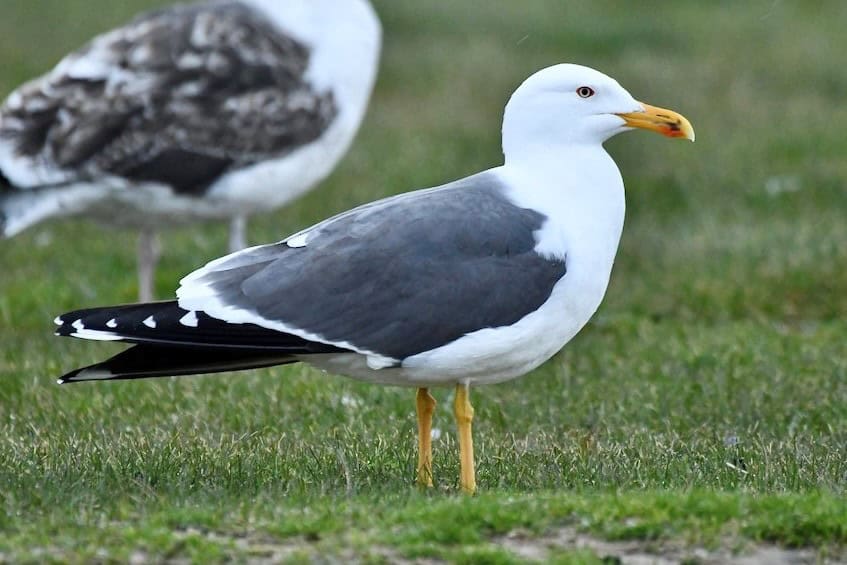
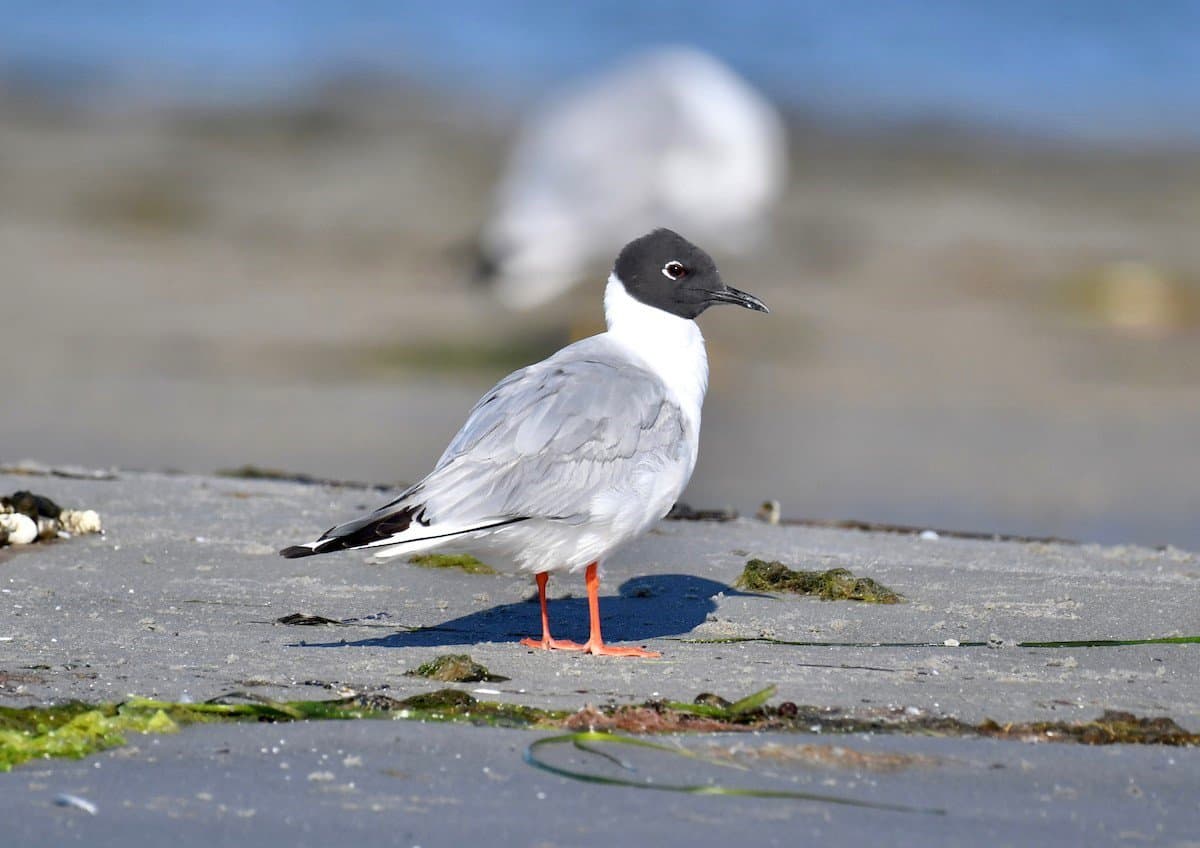

| Adult Gull Identification - Largest to Smallest *Most common | |||
| Back and Wing | Legs | Bill | |
| White Head Year-Round | |||
| *Great Black-backed Gull | Black | Pink | Yellow with Red Dot |
| *Herring Gull | Gray | Pink | Yellow with Red Dot |
| Lesser Black-backed Gull | Dark Gray | Yellow | Yellow with Red Dot |
| *Ring-billed Gull | Light Gray | Yellow | Yellow with Black Band |
| Black-legged Kittiwake | Light Gray | Black | Yellow |
| Black Head Summer (Breeding), White Winter | |||
| *Laughing Gull - Breeding | Medium Gray | Red | Red |
| *Laughing Gull - Non-Breeding | Medium Gray | Black | Black |
| Bonaparte's Gull - Breeding | Light Gray | Black | Red |
| Bonaparte's Gull - Non-Breeding | Light Gray | Pink | Black |
Terns
- Common Terns
Aptly named common terns are the tern species you are most likely to see in Maine. They breed in large flocks on offshore islands and fly out to open water in noisy groups to dive into schools of small fish. Their bodies and white and gray with a forked tail. In breeding season they have black caps and red bills and feet. By August their caps have begun to fade and bills and feet are turning black.
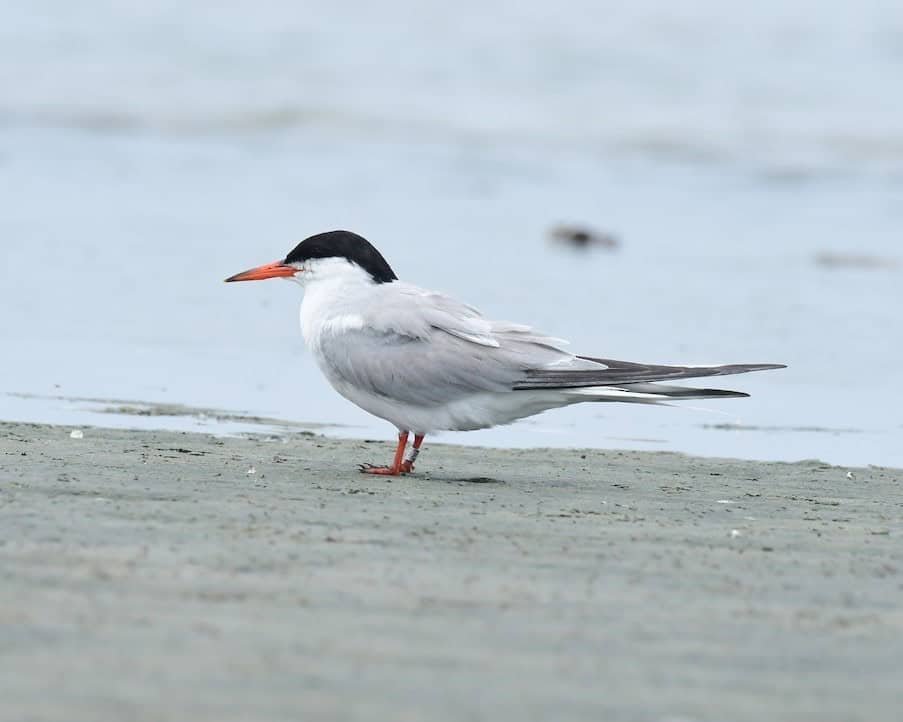
- Arctic Terns
As you move farther north you may find arctic terns which are at the south end of their breeding territory in Maine. Flying birds are difficult to tell from commons, having the same black caps and red bills during breeding season. If standing, the arctic has shorter legs and a longer tail, which often extends beyond the wing tips. Check your bird guide for a list of differences.
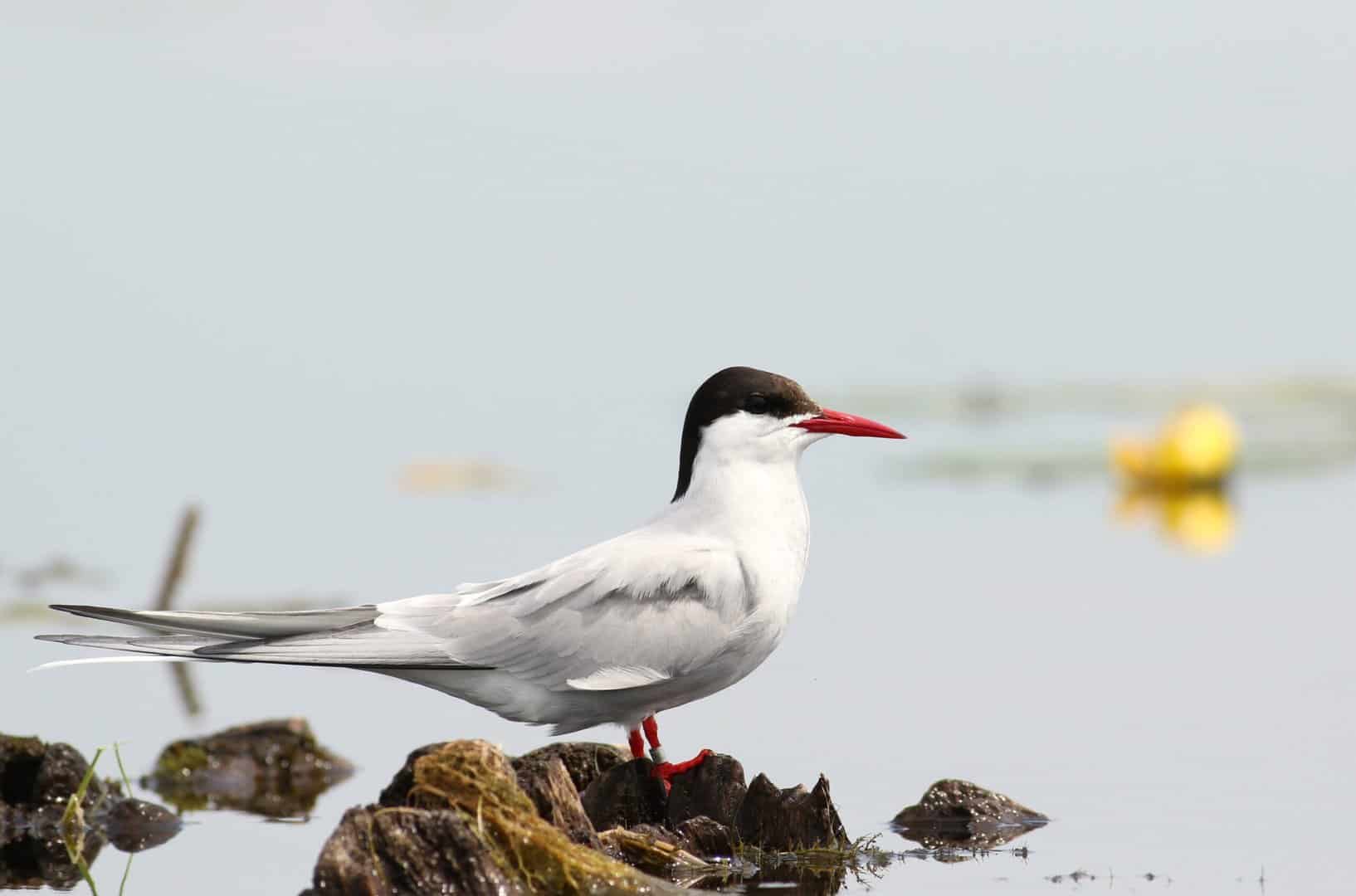
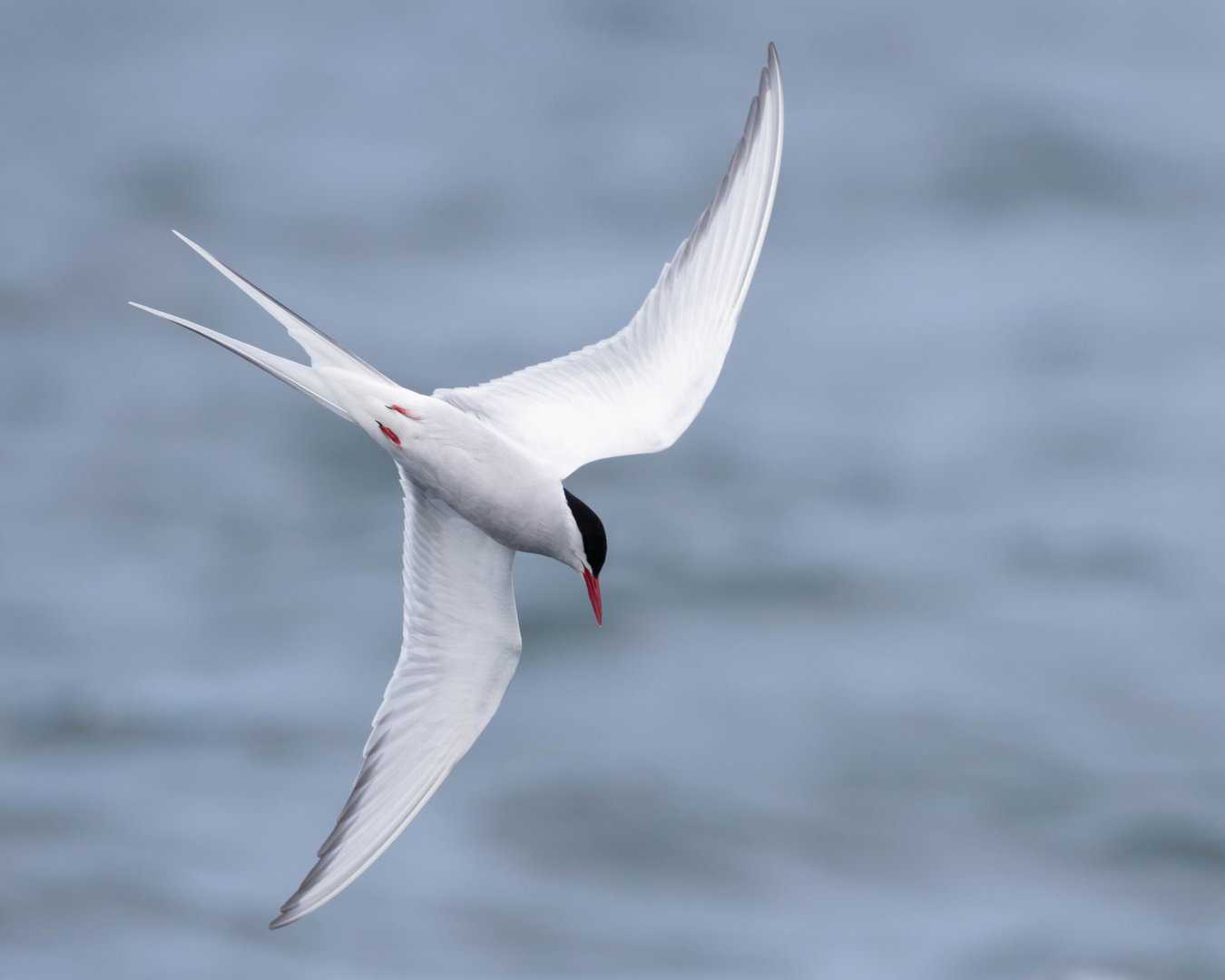
- Least Terns
Least Terns nest on beaches in Southern Maine. They are white with black caps like the commons and arctics but are smaller and have a white triangle above their yellow bills.
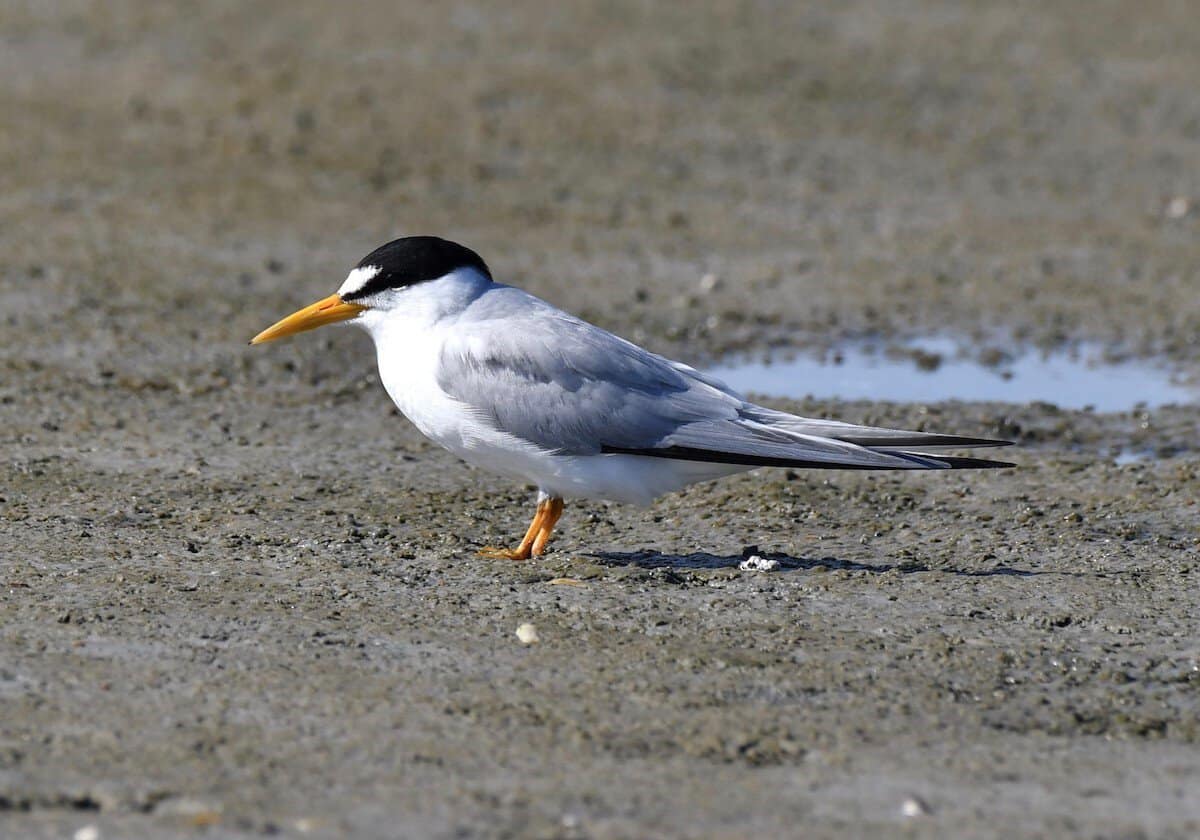
Common Loon
Common loons breed inland on Maine lakes and disperse to harbors and near shore waters in July and August. Males and females have the same black head, black and white back and white neck band separating the two. In a harbor if you often hear their haunting call and then can usually find them with binoculars.
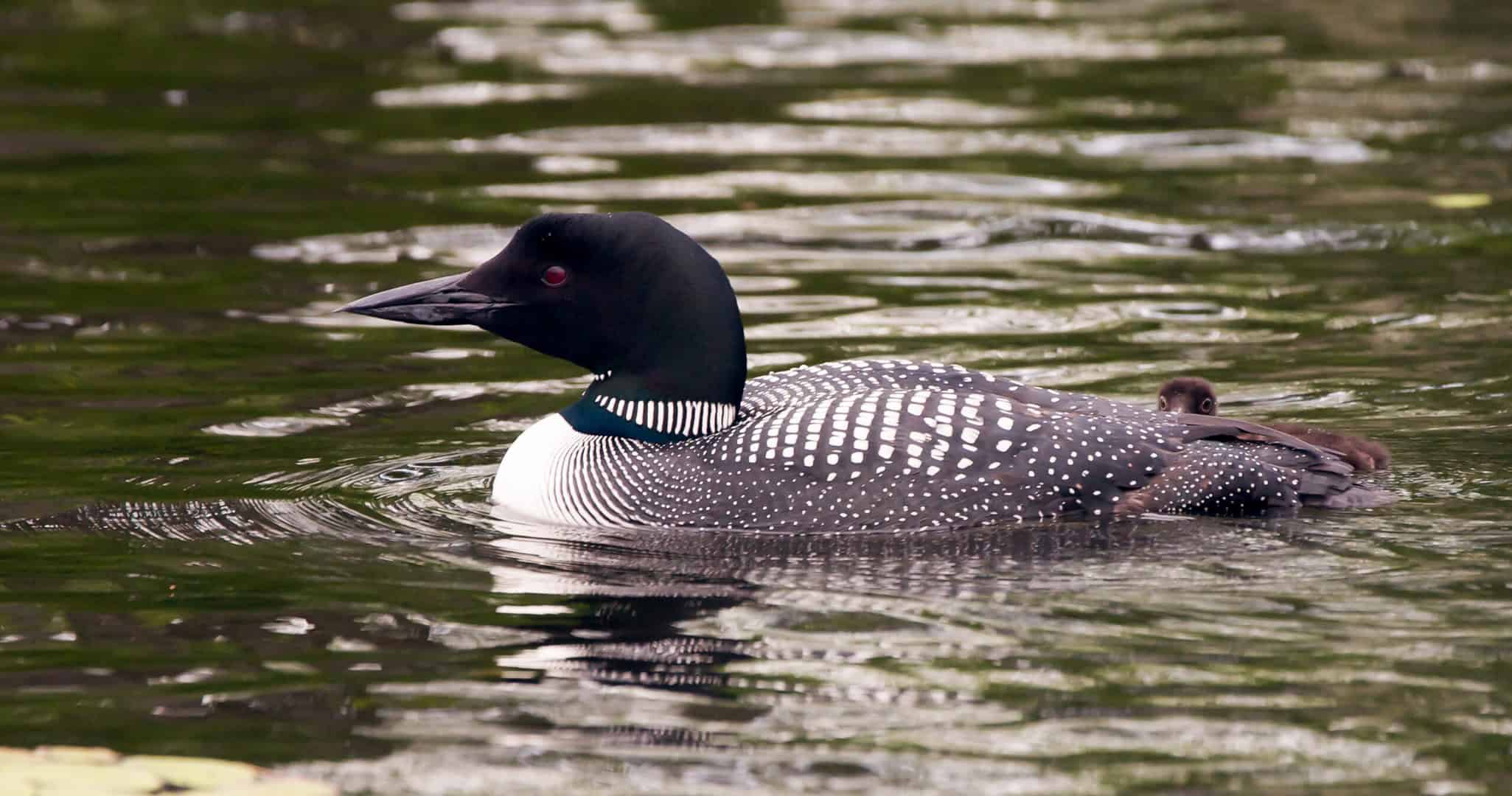
Pelagic Birds
- Shearwaters
Four shearwater species can be found offshore in Maine. All catch fish to eat by skimming just above the ocean surface offshore, interspersing wing flaps and glides depending on the bird’s size (large species flap more slowly) and wind strength. In heavy weather they glide in dramatic arcs. Shearwaters sometimes follow active fishing boats or rest in small flocks on the water.
- Great Shearwaters are the most common of the four species found in Maine. They breed in the Southern Hemisphere and migrate to North Atlantic waters to feed during the summer. Great shearwaters are dark gray above and white below with a darker cap. They might be mistaken for gulls, but gulls are chunkier, tend to fly higher off the ocean and rarely glide along the surface.
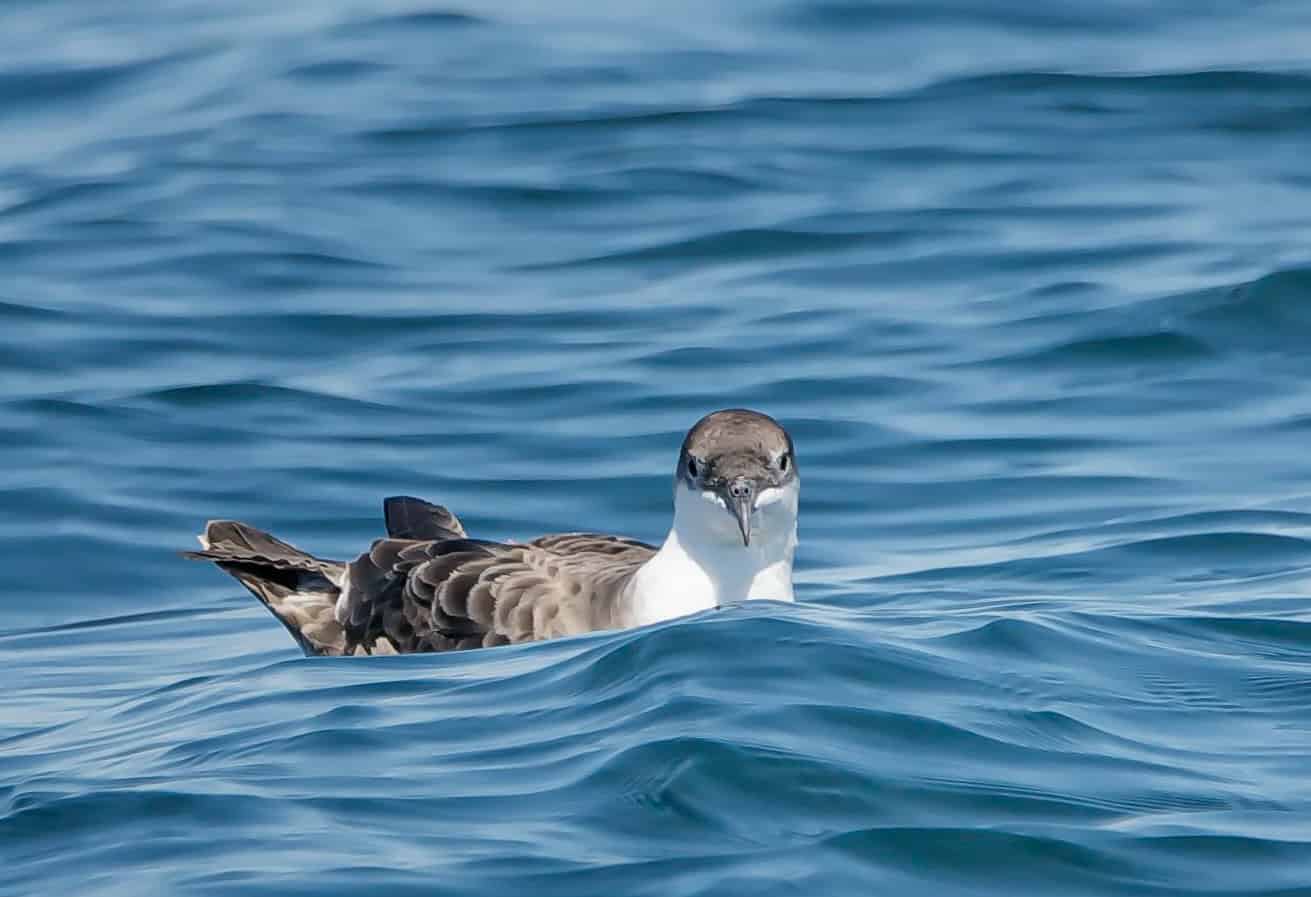
- Sooty Shearwaters are similar in breeding location, size, shape and flight style to great shearwaters, but they are dark gray all over with pale centers on the underwing.
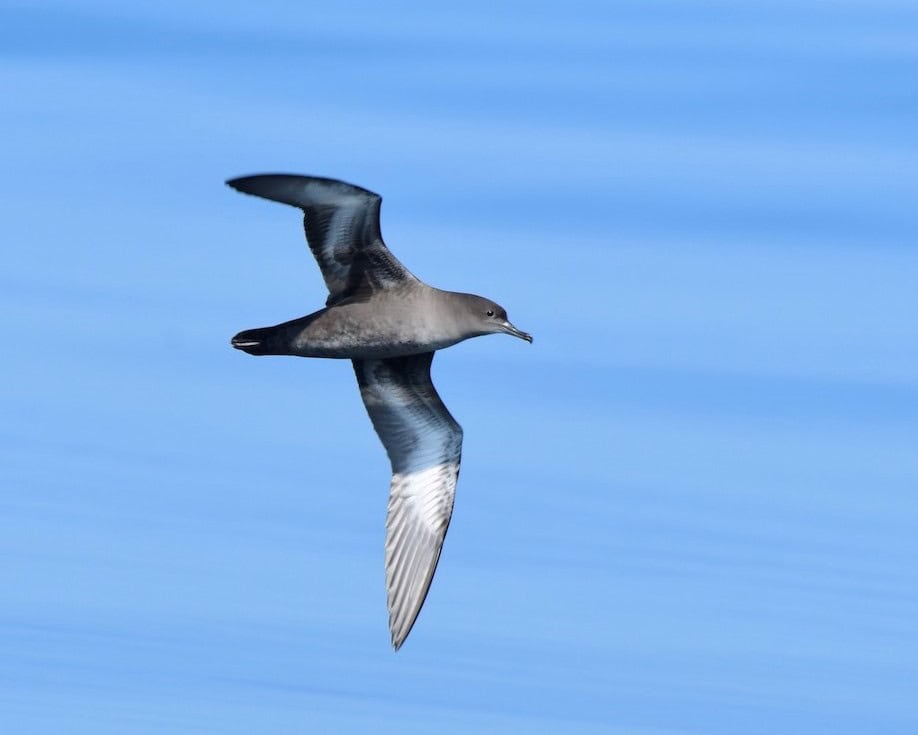
- Manx shearwater’s primary breeding area in the Western Atlantic are from Nova Scotia north, so they are easiet to find in mid to northern Maine. A good area to search is around Monhegan Island, Matinicus and south of Vinal Haven. Manx resemble great shearwaters but are smaller, with a more uniformly dark back. The dark cap extends further down the face than on the great shearwater.
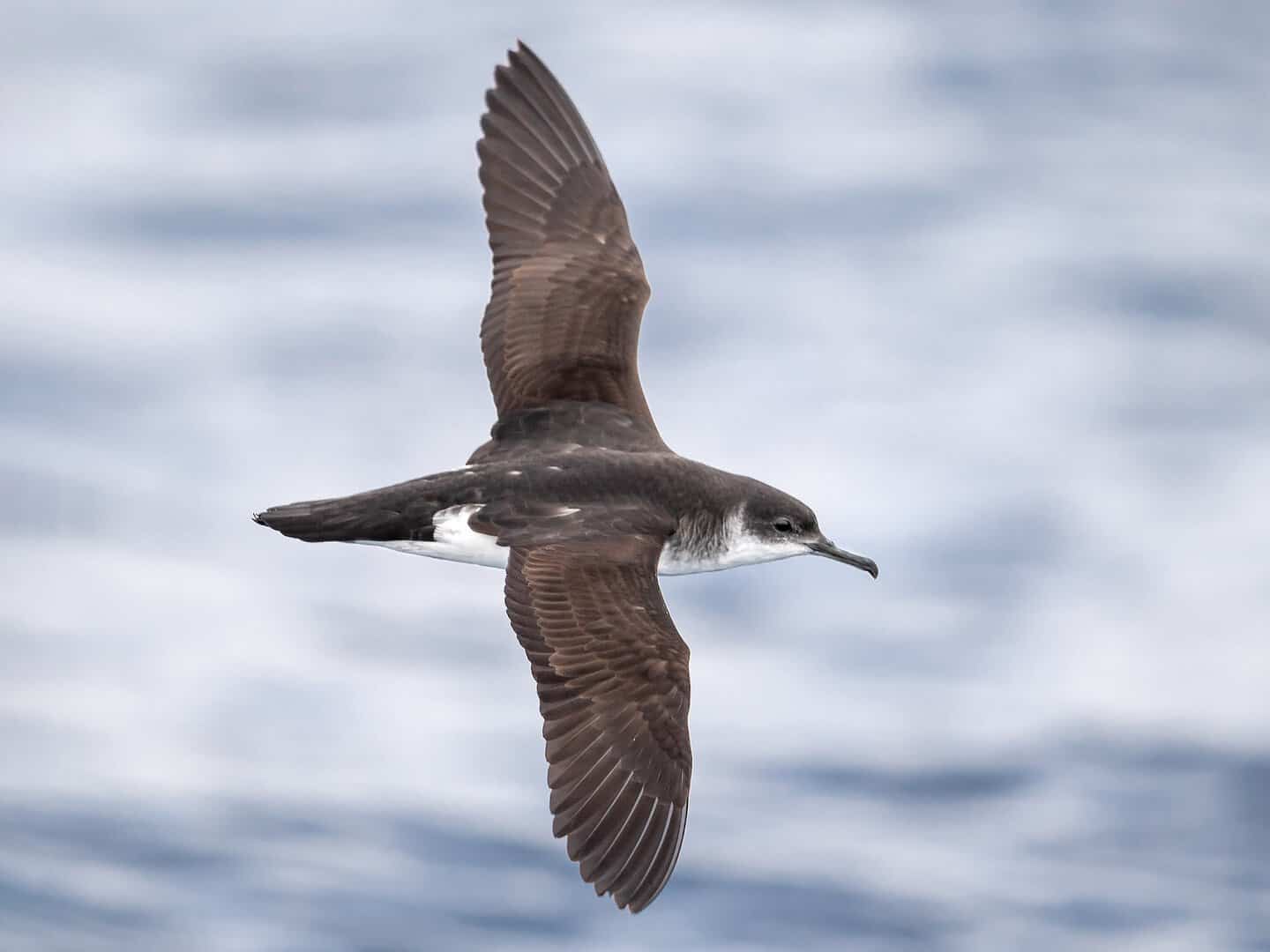
- Cory’s shearwaters breed on islands in the Eastern Atlantic. In summer they forage offshore along the coast of the United States. In Maine they are more common from the region of Matinicus Rock south. They are the largest and slowest moving of the four species found in Maine and have a dark above and light below pattern. They can be distinguished from the manx and great shearwaters by larger size, a brownish-gray back and head coloration, and a thick yellow bill.

- Storm Petrels
The two species of storm petrels found in Maine are small dark birds with bright white rump patches. They hover over the ocean surface, dip down to snatch prey and sometimes follow boats to feed in the wake.
- Wilson’s storm petrels are the most common pelagic birds seen off the coast of Maine in the summer. They breed in the Southern Hemisphere during our winter and migrate to the North Atlantic in the summer to feed. Based on prey distribution and weather, they can sometimes be seen from shore and even in harbors. Wilson’s storm petrels have a wide arced white stripe at the base of the tail which extends around to the sides of the body. Their flight is fluttery and butterfly-like.

- Leach’s storm petrels have the opposite breeding cycle from the Wilson’s storm petrels. They breed on treeless offshore islands during Maine summers. They are harder to find than Wilson’s because they head offshore to fish before sunrise and return after dark. If you are anchored near one of their breeding islands you may hear their distinctive call at night as they return to the nests—a single high-pitched note and then a purring sound. Their white rump patch does not extend around to the sides of the body and is often split in the middle. Their wing strokes in flight are deeper and slower than Wilson’s.
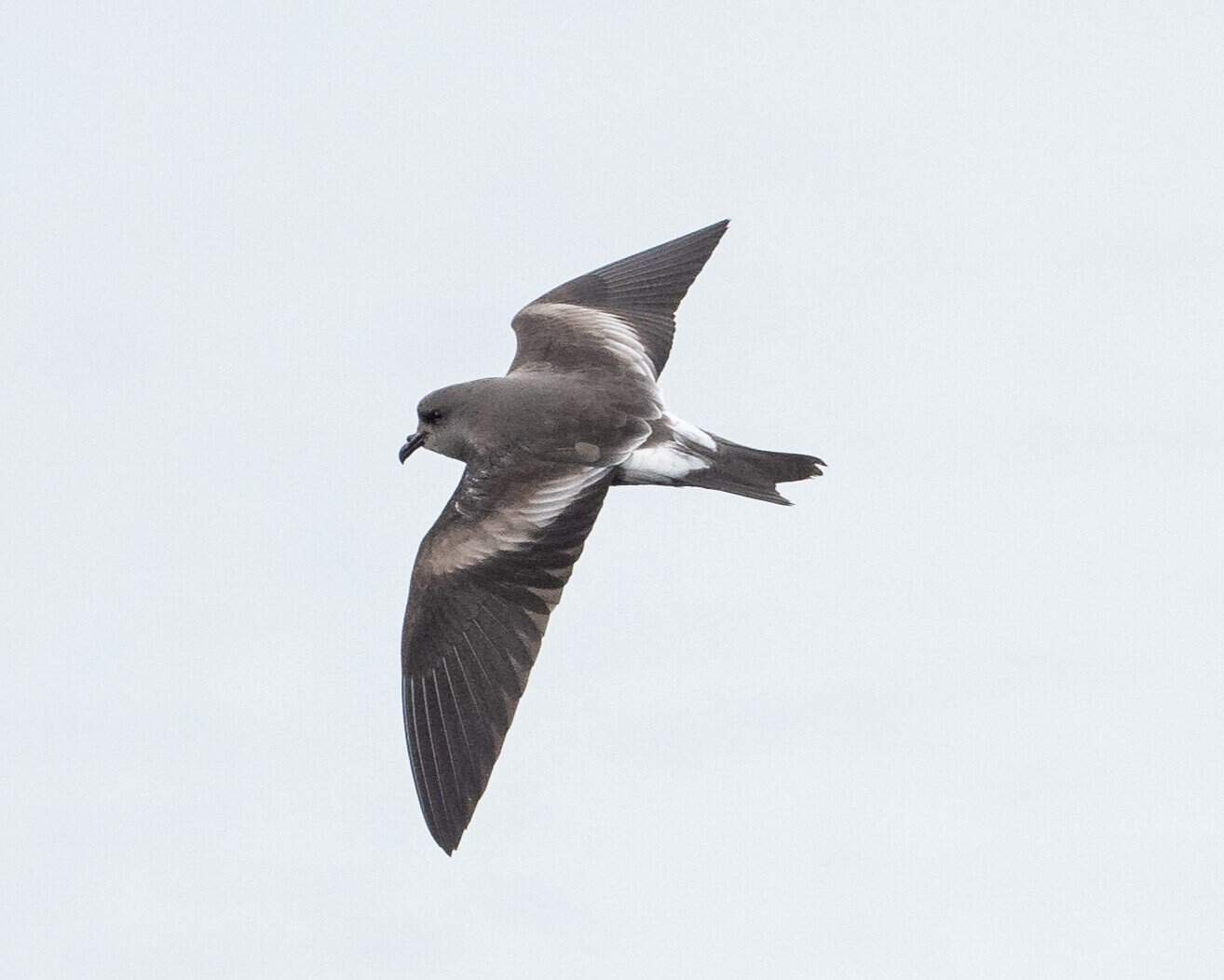
Northern Gannet
Northern Gannets are large seabirds which nest on in colonies on islands off Newfoundland and in the Gulf of St. Lawrence. They disperse to Maine waters after breeding or when immature. Adults are white with cream-colored heads and extensive black wing tips. First year birds are brown and they take 3 to 4 years in various splotchy brown and white patterns before they attain adult plumage. Gannets have a distinctive feeding style--diving straight down into the sea catch their prey.
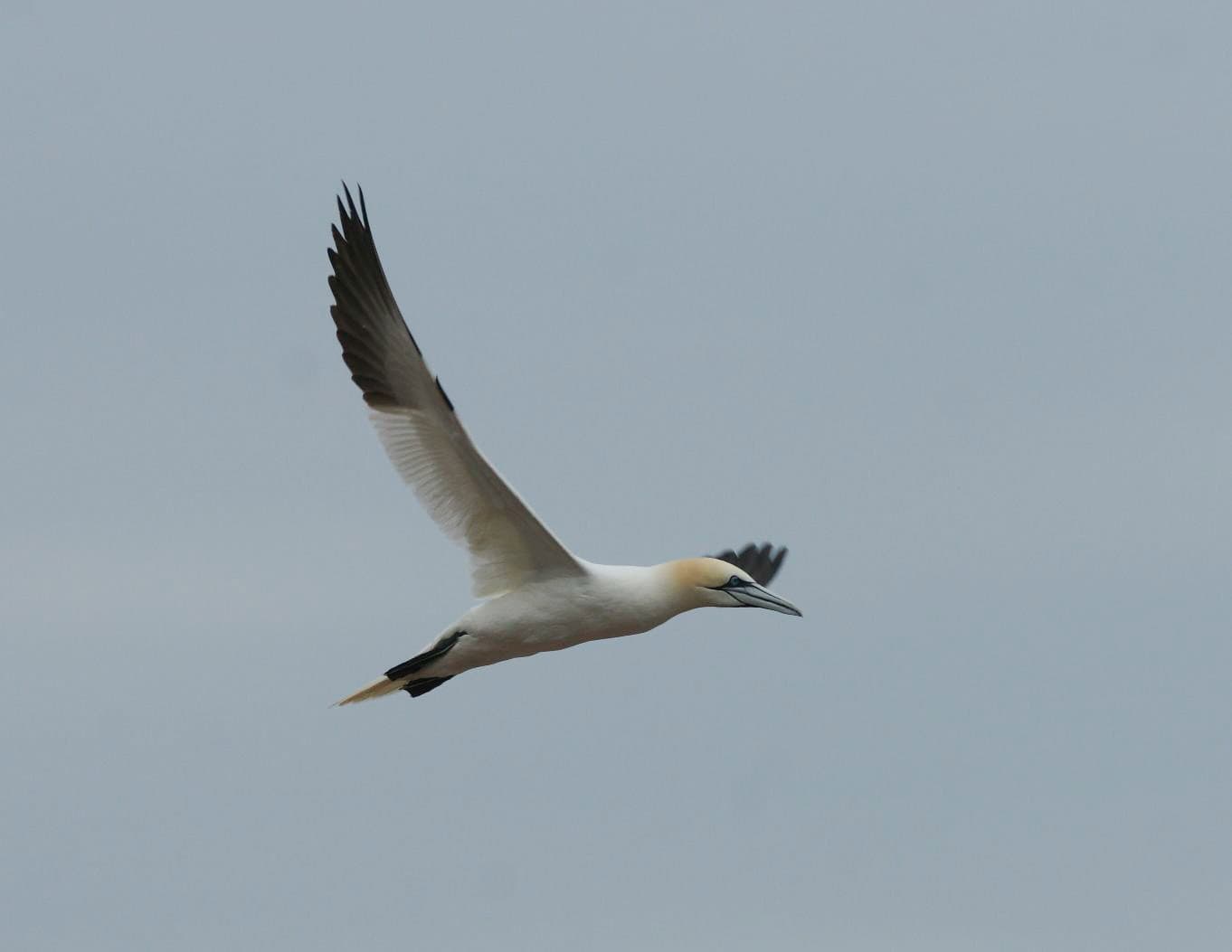
Double-crested Cormorant
One of the most common birds seen near shore in Maine is the double-crested cormorant. They dive and swim rapidly and after fish, often just showing their heads above water. Their favorite perches for resting and drying their wings are docks and rocky outcrops. The adults are shiny black with yellow-orange facial skin around the bill. Immature birds are dark brown with pale breasts.
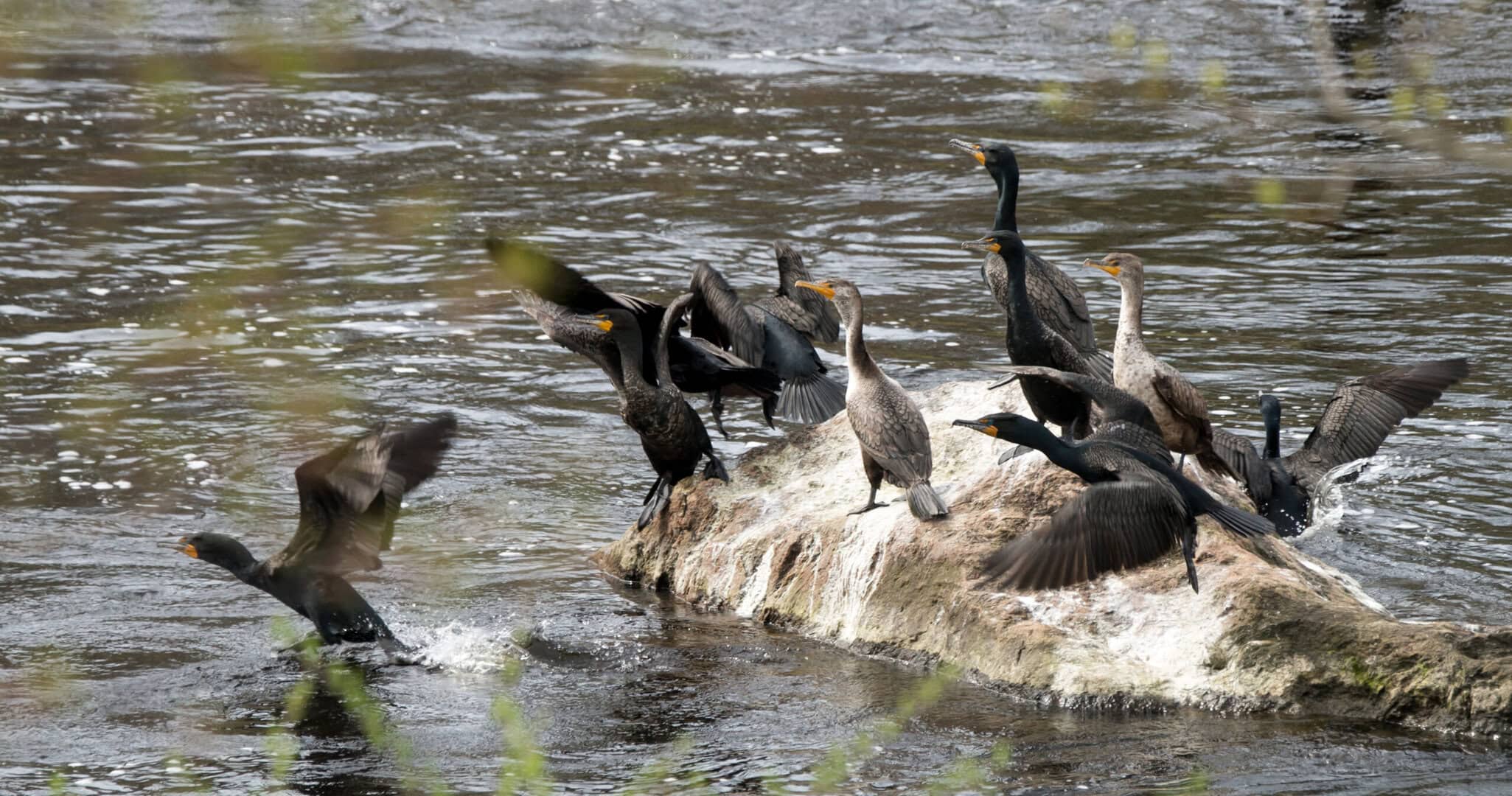
Herons and Egrets
- Great blue heron are distinctive 4-foot tall, long-legged waders found throughout Maine in the summer. They stalk the edges of fresh water and brackish shores and marshes looking for prey. More gray than blue, they have white faces and a dark “eyebrow.”
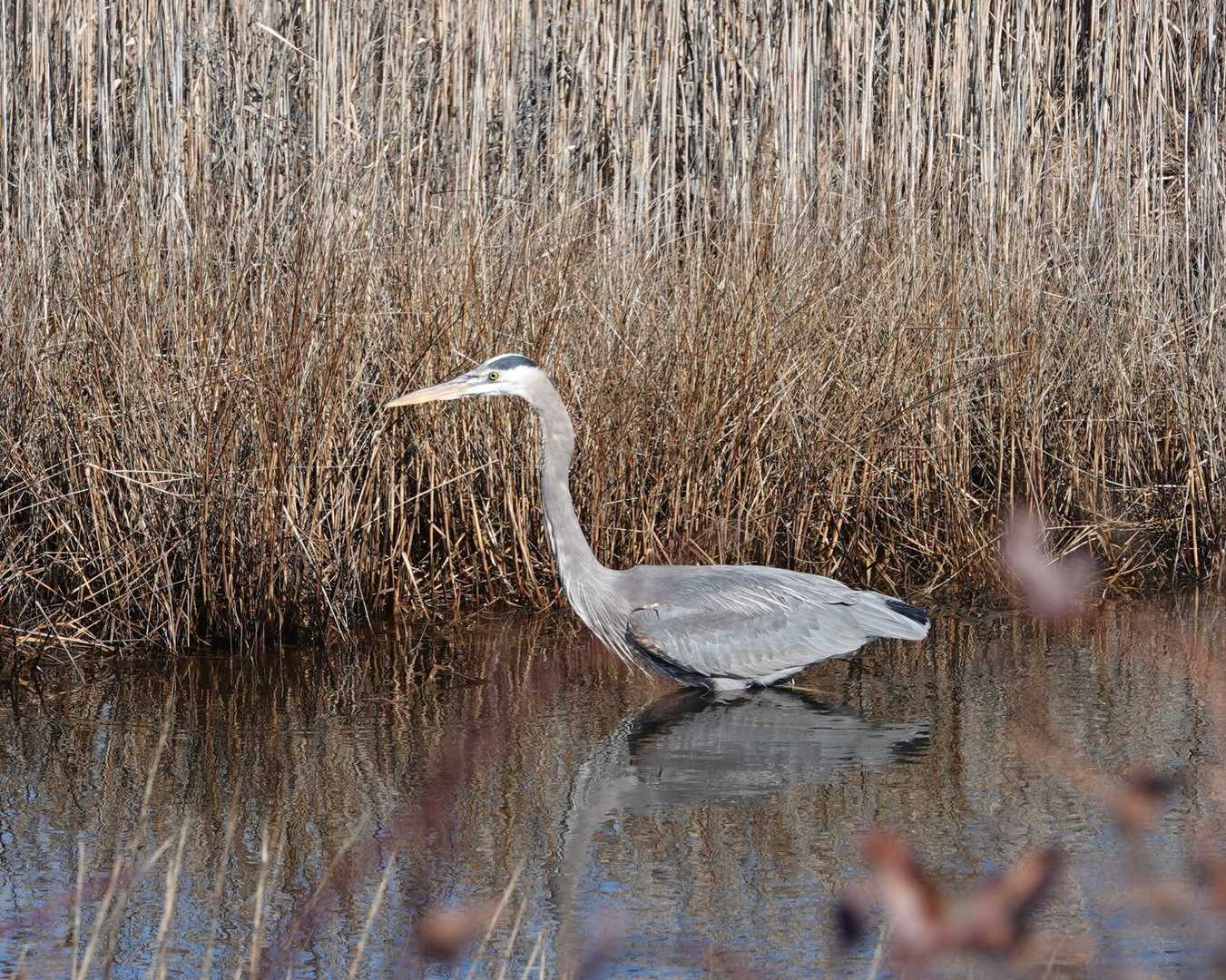
- Great egrets are summer residents in Maine, found in shore and marsh habitats as far north as Canada, but more commonly in the south. They are nearly as tall as blue herons, all feathered in white with a long slender neck, a yellow bill and dark legs.
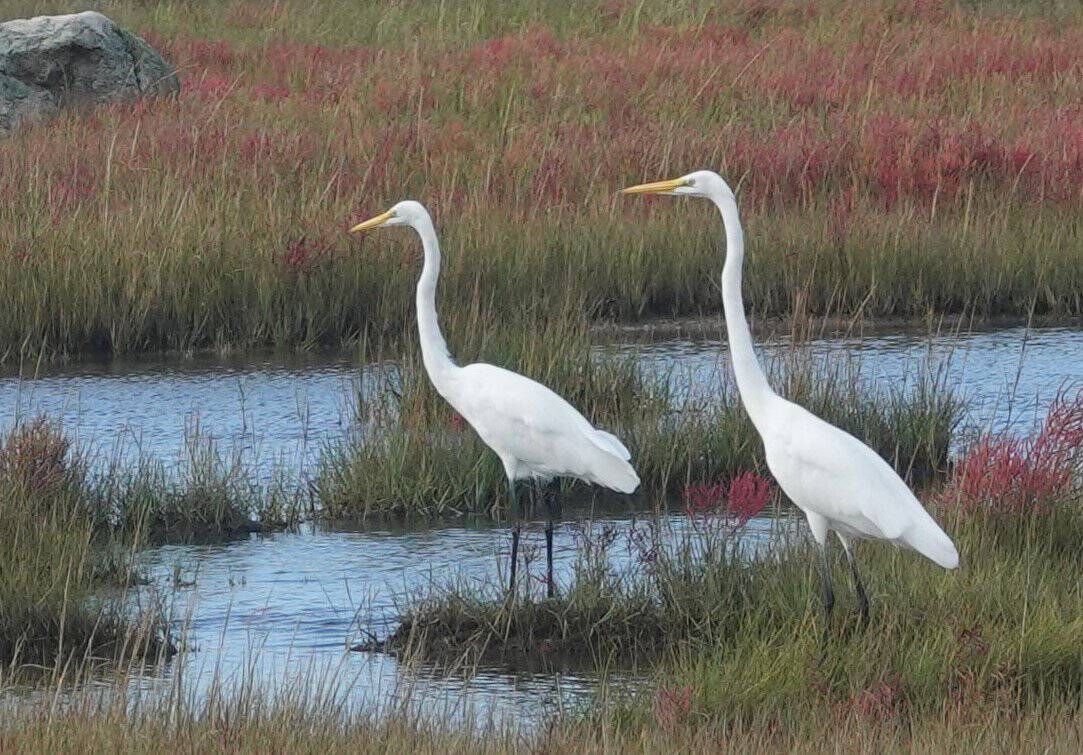
- Snowy Egrets are also summer residents of Maine-- common in marsh and shore habitat south of Casco Bay, but rarer as you go farther north. These egrets are also all white, but approximately half the size of great egrets. The easiest way to tell the two similar species apart is by bill and leg color. Snowy egrets have black bills and legs with bright yellow feet.

Raptors
- Bald Eagle
Fifty years ago bald eagles were rare in Maine, but now are common breeders throughout the state. They are omnivorous eaters but prefer fish. Everyone knows what the adult US National Bird looks like—brown with a white head and tail and a yellow bill. But they take four years to gain this plumage. The juveniles are dark brown all over; second- and third-year birds are variously splotchy brown and white.

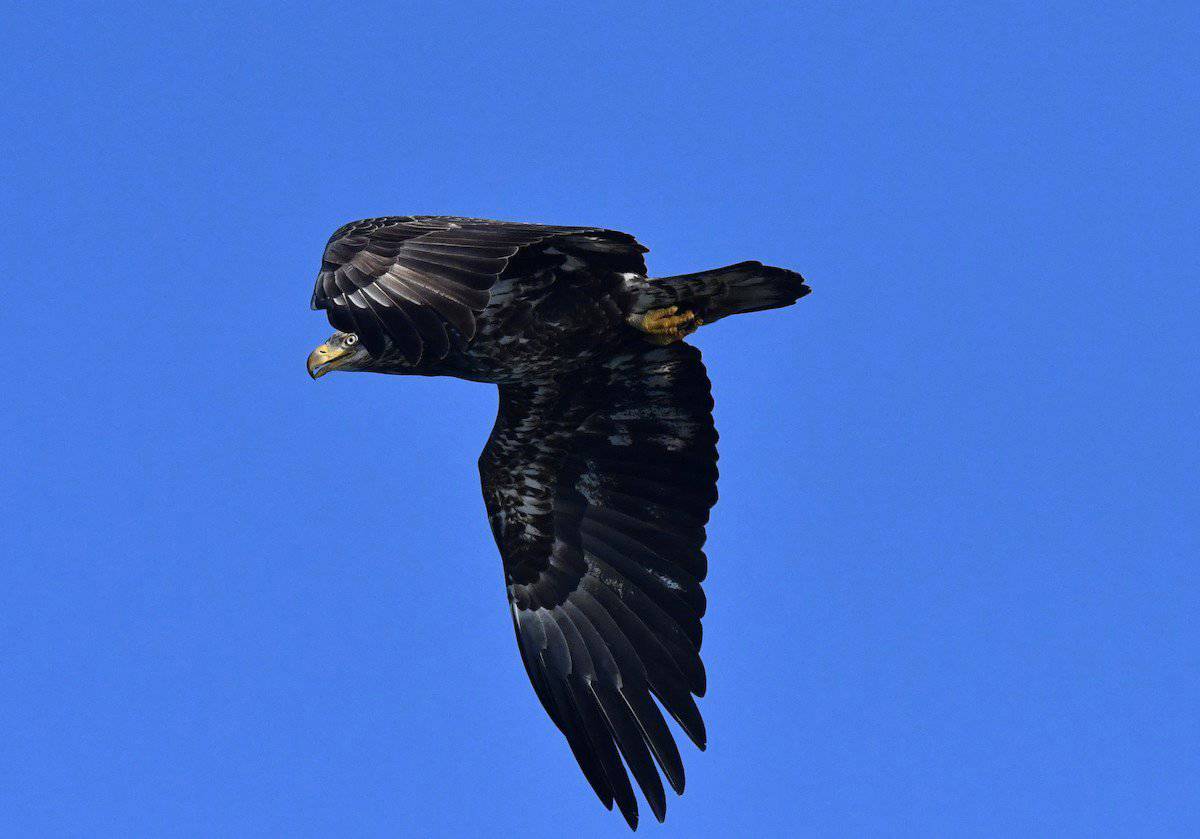
- Osprey
Ospreys breed in Maine and migrate south in winter. They build messy stick nests on man-made nest poles, telephone poles and trees with sizeable horizontal branches near water where they can dive for fish. They are smaller but more agile than bald eagles and sometimes compete for the same prey. They have dark brown wings and white heads so they can be mistaken for bald eagles. Look for white throughout the undersides and a black eye-stripe on the white head. Males have all white breasts; females have a “necklace” of dark spots.
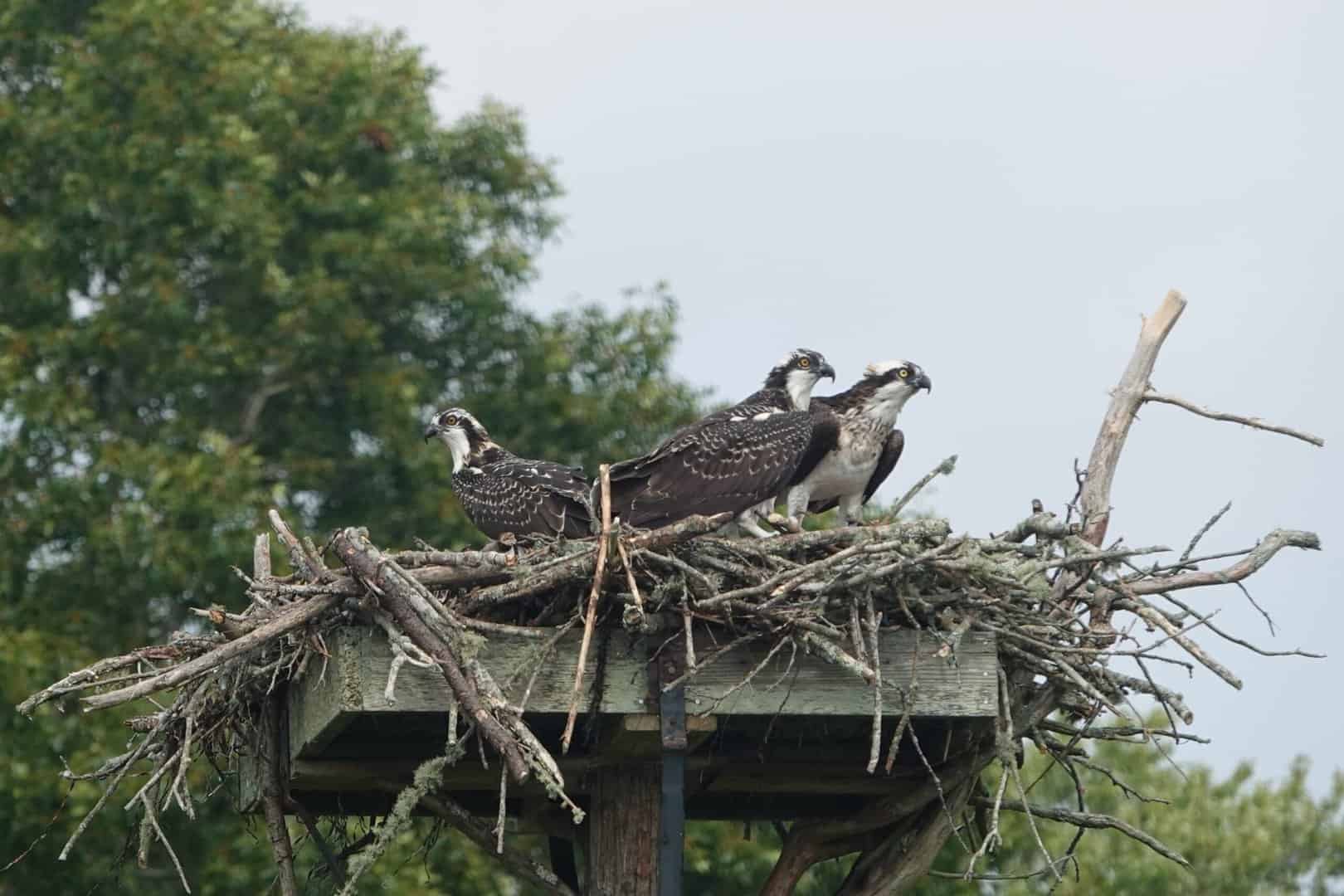
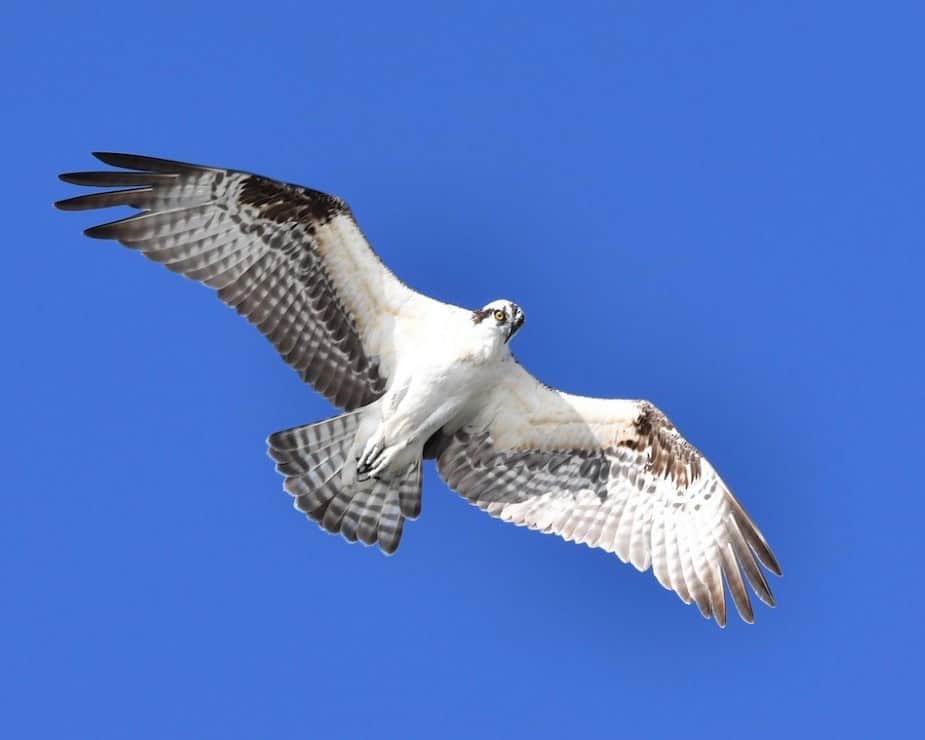
Belted Kingfisher
Belted Kingfishers are found in harbors and inland waterbodies throughout Maine. They sit on horizontal branches at the edge of the water watching for fish. When prey is spotted they hover above and dive for it, usually giving a distinctive rattle call when they fly. In most bird species with sexual differentiation the males are more colorful than the females. Belted kingfishers are the opposite. Both sexes are blue on the back and head with white underparts. The male has a blue band across the chest. The female has an additional band of orange.
